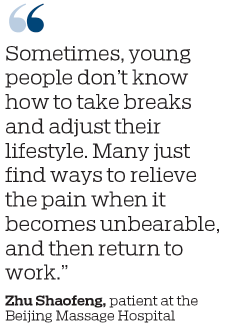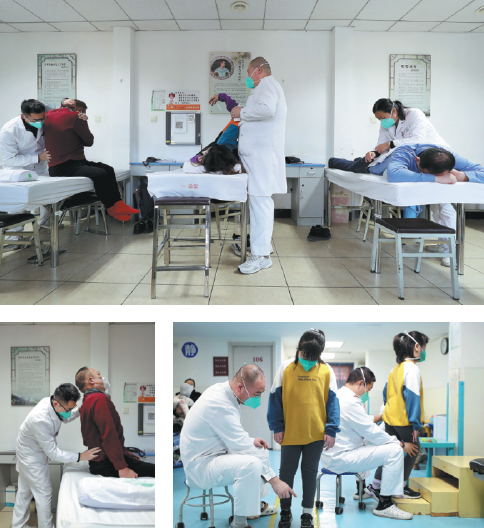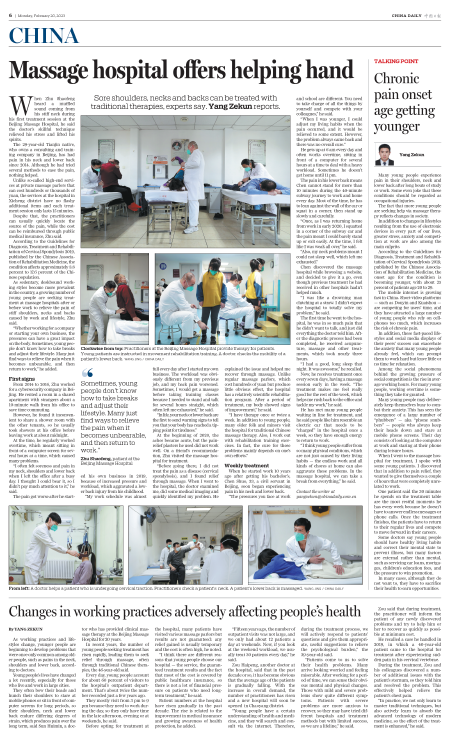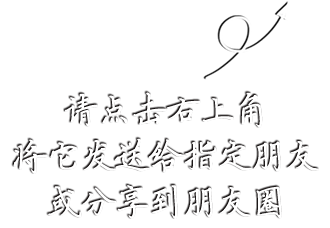

Clockwise from top: Practitioners at the Beijing Massage Hospital provide therapy for patients. Young patients are instructed in movement rehabilitation training. A doctor checks the mobility of a patient's lower back.

From left: A doctor helps a patient who is undergoing cervical traction. Practitioners check a patient's neck. A patient's lower back is massaged.
When Zhu Shaofeng heard a muffled sound coming from his stiff neck during his first treatment session at the Beijing Massage Hospital, he said the doctor's skillful technique relieved his stress and lifted his spirits.
The 29-year-old Tianjin native, who owns a consulting and training company in Beijing, has had pain in his neck and lower back since 2014. Although he had tried several methods to ease the pain, nothing helped.
Unlike so-called high-end services at private massage parlors that can cost hundreds or thousands of yuan, the services at the hospital in Xicheng district have no flashy additional items and each treatment session only lasts 15 minutes.
Despite that, the practitioners can usually quickly locate the source of the pain, while the cost can be reimbursed through public medical insurance, Zhu said.
According to the Guidelines for Diagnosis, Treatment and Rehabilitation of Cervical Spondylosis 2019, published by the Chinese Association of Rehabilitation Medicine, the condition affects approximately 3.8 percent to 17.6 percent of the Chinese population.
As sedentary, deskbound working styles become more prevalent in the country, a growing number of young people are seeking treatment at massage hospitals after or before work to relieve the pain of stiff shoulders, necks and backs caused by work and lifestyle, Zhu said.
"Whether working for a company or starting your own business, the pressures can have a great impact on the body. Sometimes, young people don't know how to take breaks and adjust their lifestyle. Many just find ways to relieve the pain when it becomes unbearable, and then return to work," he added.
First signs
From 2014 to 2016, Zhu worked for a cybersecurity company in Beijing. He rented a room in a shared apartment with strangers about a 10-minute walk from his office to save time commuting.
However, he found it inconvenient to share a shower room with the other tenants, so he usually took showers at his office before leaving work at about midnight.
At the time, he regularly worked overtime, which meant sitting in front of a computer screen for several hours at a time, which caused many problems.
"I often felt soreness and pain in my neck, shoulders and lower back when I left the office after a busy day. I thought I could bear it, so I didn't pay much attention to it," he said.
The pain got worse after he started his own business in 2019, because of increased pressure and workload, which aggravated a lower back injury from his childhood.
"My work schedule was almost full every day after I started my own business. The workload was obviously different from my previous job, and my back pain worsened. Sometimes, I would get a massage before taking training classes because I needed to stand and talk for several hours straight, which often left me exhausted," he said.
"In life, your neck or lower back are the first to send warning signs to tell you that your body has reached a tipping point for tiredness."
At the beginning of 2020, the aches became acute, but the pain-relief plasters he used did not work well. On a friend's recommendation, Zhu visited the massage hospital for treatment.
"Before going there, I did not treat the pain as a disease (cervical spondylosis), and I found relief through massage. When I went to the hospital, the doctor examined me, did some medical imaging and quickly identified my problem. He explained the issue and helped me recover through massage. Unlike regular massage parlors, which cost hundreds of yuan but produce little obvious effect, the hospital has a relatively scientific rehabilitation program. After a period of treatment, my body showed signs of improvement," he said.
"I have therapy once or twice a week. In addition to young people, many older folk and minors visit the hospital for traditional Chinese massage therapy. Also, I work out with rehabilitation training exercises. In fact, the cure for these problems mainly depends on one's own efforts."
Weekly treatment
When he started work 10 years ago after getting his bachelor's, Chen Shuo, 33, a civil servant in Beijing, soon began experiencing pain in his neck and lower back.
"The pressures you face at work and school are different. You need to take charge of all the things by yourself and compete with your colleagues," he said.
"When I was younger, I could adjust my living habits when the pain occurred, and it would be relieved to some extent. However, the problem always came back and there was no overall cure."
He gets up at 6 am every day and often works overtime, sitting in front of a computer for several hours at a time to deal with a heavy workload. Sometimes he doesn't get home until 11 pm.
The pain in his lower back means Chen cannot stand for more than 10 minutes during the 40-minute subway journey to work and home every day. Most of the time, he has to lean against the wall of the car or squat in a corner, then stand up slowly and carefully.
"Once, as I was returning home from work in early 2020, I squatted in a corner of the subway car and the pain meant I could barely stand up or exit easily. At the time, I felt like I was weak all over," he said.
"Also, my neck problems meant I could not sleep well, which left me exhausted."
Chen discovered the massage hospital while browsing a website, and decided to give it a go, even though previous treatment he had received in other hospitals hadn't helped much.
"I was like a drowning man clutching at a straw. I didn't expect the hospital to totally solve my problem," he said.
The first time he went to the hospital, he was in so much pain that he didn't want to talk, and just did everything the doctor told him. After the diagnostic process had been completed, he received acupuncture, massage and other treatments, which took nearly three hours.
"I had a good, long sleep that night. It was awesome," he recalled.
Now, he receives treatment once every seven days, having a massage session early in the week. "The treatment makes me feel really good for the rest of the week, which helps me rush back to the office and tackle my work," he said.
He has met many young people waiting in line for treatment, and he said people like him resemble an electric car that needs to be "charged" in the hospital once a week, so they have enough energy to return to work.
"I think young people suffer from so many physical conditions, which are not just caused by their living habits — the endless work and all kinds of chores at home can also aggravate these problems. In the massage hospital, we can take a break from everything," he said.
Contact the writer at yangzekun@chinadaily.com.cn

